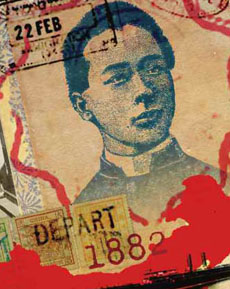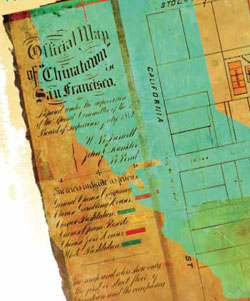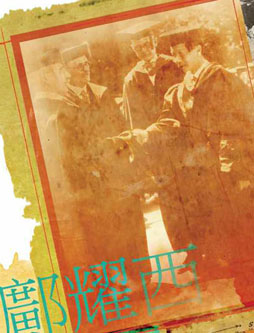Sonoratown, Little Italy, China City, Chinatown, Los Angeles, Ca.
from Elisabeth L. Uyeda's Blogg Los Angeles Revisited
 |
| Image courtesy Seaver Center for Western History Research |
 |
| Image courtesy Seaver Center for Western History Research |
Despite the lack of exoticism along these parts, the area's colorful history more than makes up.
Losing "Old" Chinatown (1933)
The obliteration of Old Chinatown, near Alameda and Aliso Streets, began on a Friday morning, December 22nd of 1933. Legal challenges against the destruction only postponed the inevitable. The Union Passenger Terminal or Union Station was eventually built on the cleared land, and the first train arrived in May of 1939. By 1942 the streets and alleyways erased included Apablasa, Cayetano, Juan, Marchessault and Napier Streets.
Early Chinese residents settled in Los Angeles after the completion of the transcontinental railroad in 1869. Men found new work and eked out their living in such occupations as vegetable peddler. The Chinese community was victim to the most violent event in the young city's history during the Chinese Massacre on October 24, 1871.
New High, Ord and Spring Streets
A study of Dakin's fire insurance atlas for the year 1888 discloses that Chinese businesses and rooming houses existed outside of Chinatown proper, namely by New High Street (Calle Alta was the earlier name). See further below for a discussion on early Chinese areas outside of Old Chinatown. Later in this blog post two other nearby streets will be covered: Ord Street (formerly Alta, then Walters Street), and North Spring Street (originally called Street of the Maids, then changed to Upper Main in the 19th century, then was known as San Fernando by 1897.) From the 19th century into the early 20th, these three streets were known as a part of Sonoratown for its Mexican residents. Italians also settled in this neighborhood.
New Chinatown (est. 1938)
The Chinese American community found a new core location when its leaders managed to strike a deal and acquired vacant land owned by the Santa Fe Railroad. New Chinatown opened June 26, 1938, and it was anchored by a central pedestrian plaza on Broadway north of College Street. The architectural layout and facades have basically not changed all these years.
Also in 1938 two Chinese businesses appeared in that year's city directory listed at 700 and 701 North Spring Street near Ord. This location was several blocks away from the central plaza. These businesses did not cater to the tourist. These stores were situated adjacent to China City (to be discussed below.)
Wai Sang Meat Company (700 Spring) and Kwong Dack Wo Company (702 Spring) were meat and grocery markets respectively. (My parents regularly frequented these markets in the 1960s. Both stores were listed as recent as in the 1973 city directory.) Today, both units house the CBS Seafood Restaurant.
 |
| Notice on the picture's right side at the rear of CBS that the lit Philippe's sign is visible (Click to zoom in) |
CBS Seafood Restaurant opened in 1999. Their parking lot next to the restaurant has been watched by congenial Security Officer E. Reed since the restaurant opened. Mr. Reed said he has only missed three work days when he tried a stint at the new Disney Concert Hall but decided he preferred the Chinatown beat. He is amazingly warm and welcoming to CBS patrons.
 |
| E. Reed and restaurant manager D. Ho shootin' the breeze in the parking lot |
The CBS site history includes a three-story handsome brick building constructed by the summer of 1888 and named the Tononi Block, for its owner, an Italian, Giacomo Tononi. The businesses at these locations were a saloon/billiard parlor (700 Upper Main) and wine & liquor store (702 Upper Main.) Later his widow, Isabel Pelanconi Tononi, lived in one of the upstairs lodging quarters briefly (704 1/2 San Fernando - this address was sometimes listed as the San Fernando Hotel, as recent as 1956.) She was the great-granddaughter of a Spanish soldier Cornelio Avila who built one of the early adobes bounded near today's North Broadway, College, Spring and Alpine Streets.
 |
| Lower 'pink' areas show the brick buildings of the Sunset Hotel and the Tononi Block across the street (Courtesy Seaver Center) (Click on image to zoom in) |
The very corner unit (700 San Fernando) also served for many years as grocer Casimiro Michelini's store, as listed in the 1897, 1901 and 1909 city directories.
 |
| The Tononi Block is partially blocked by the tree in right foreground. Across the street was an even taller building, the Sunset Hotel at 703 Upper Main Street (Image courtesy Seaver Center) |
It does not appear likely that today's CBS is on the original floor of the Tononi Block, however, the County Assessor's record still lists this site as built in 1887. A big question -- when was the building razed? One clue comes from directory listings that place the Tononi building still possibly standing in 1956.
Across the street from the Tononi was the Sunset Hotel at 703 Upper Main. (This hotel would have been only a short distance from the "San Fernando Street" depot stop of the railroad.)
Another unknown is year that the imposing Sunset Hotel went away. The County Assessor lists the building where the hotel should have sat as 207 Ord (built 1880). Today's single story building does not seem to be derived from the hotel. 207 Ord is a long single story building (maybe like the footprint of the old hotel), and Hoy King Restaurant operates here.
 |
| The 207 Ord Street building (built 1880; renovated 1935) is showing its age |
Across the street southward from the former Tononi Block was an adobe structure at the southeast pictured below with street signs of Ord and San Fernando. Adobe homes were prevalent on these streets - settled by the early Spanish and Mexican soldiers and other persons of means in the early to mid-19th century.
 |
| Look closely at the left side for a downhill descent of Ord Street (today a walk downhill would lead to Philippe's) (Courtesy Seaver Center) |
Directly across the street is the spot first introduced at the beginning image of this blog posting. There is still a theater, though now called King Hing Theater:
The Dakin 1888 insurance atlas surprisingly reveals that in this 600 block there was a significant concentration of Chinese quarters, labeled in the atlas "Chinese" Chin. Rest." "Chinese Wash" "Chin. Board'g" "Chin. Tea" and "Chin Rooms." These notations provide indication that Chinese resided outside of the "Old" Chinatown community.
 |
| (Click to Zoom) (Courtesy Seaver Center) |
Today's best-known landmark in the area is Philippe's French-Dipped Sandwiches at 1001 Alameda Street, along Ord Street. Back in 1888 this famous corner was a vacant lot. Displaced from their location on Aliso Street by new freeway consruction, Philippe's moved here in 1951.
China City (est. 1938)
Across the street from Philippe's, Ord Street was the north boundary for "China City" the Chinese tourist compound created by the "mother of Olvera Street" Christine Sterling. It opened in June of 1938, a few weeks earlier than New Chinatown's opening. China City was partly Sterling's solution for the displaced Chinese community. Less than a year later, a suspicious fire burned in the main section. After being rebuilt, China City operated for about ten years before another fire brought its demise. China City extended to Spring Street on the west, Main Street on its east side, and reaching south to Macy Street (today's Cesar E. Chavez Avenue.)
There might be a historical remnant -- at Philippe's parking lot across the street from the restaurant hangs a neon sign which reads "Shanghai Street." Shanghai Street existed in China City so this might have been an authentic, salvaged sign.
Sonoratown
In the 19th century, the city blocks considered today's New Chinatown was home to a different ethnic group: Hispanics. The barrio developed and resulted from demographic changes following the American period of the city after 1850. Whereas Mexican and Hispanic residents once comprised more than half the population, new Anglo settlers changed the equation. A segregated area north of the Los Angeles Plaza became inhabited by Mexicans and referred disparagingly as Sonoratown by Anglos. A study (The Los Angeles Barrio, 1850-1890 by Richard Griswold Del Castillo) delineated that the most concentrated ethnic enclave between 1872 through 1888 was the large area bounded by Main, College, Yale and Short (formerly Corta Street, about where Sunset Boulevard is today.) Two of the main thoroughfares in Sonoratown were Castelar (today's North Hill Street) and Buena Vista (originally Calle de la Eternidad and today's North Broadway.)
Early Real Estate Subdivision Nearby
Prudent Beaudry, who served as City Mayor and who was also the developer of Bunker Hill, subdivided the hill to the west of Sonoratown about 1884.
 |
| Courtesy of the Seaver Center for Western History Research |
More on New High, Ord and Spring Streets
New High, Ord and Spring may have been the fringe of Sonoratown. There was also a concentration of homes and businesses to Italians as part of L.A.'s Little Italy in the 19th century. In 1897 and 1901, Soon Wo laundry was listed at 688 San Fernando. In 1901, Yik Wo had a tailor business at 674 San Fernando. In the 1909 city directory, the businesses and residents appear ethnically integrated by whites and Hispanics, without Chinese names listed. At 751 San Fernando Street was the Church of St. Peter. By 1938, New High Street (600-700 block) was mostly Hispanic, but in light of the new Chinese settlements (New Chinatown and China City) subsequent city directories showed increasing Chinese business and residential listings.
The 1943 city directory indicates these city blocks a mix of Italian, Chinese and Hispanic residents and businesses. By 1956, the following line of businesses on Ord Street reflected the diversity: 120 Ord - Flora's; 122 Ord - F. Suie One Co. Chinese Goods; 124 Ord - Jun Quon Hin; 207 Ord - Chung Mee Cafe; 301 Ord - Juarez Cafe; 302 Ord - Lake Sun; 304 Ord - El Capricho Cafe.
At 708 New High, the corner lot sits ABC Seafood Restaurant. Prior to their venture, the Limehouse was here. One of their predecessors was the J.G. Medina Grocery operating in an old adobe after vacated by the El Adobe Cafe. Click here to see a photo from the LAPL archive.
Across the street the Phoenix Inn Restaurant opened at the corner of 301 Ord Street in the year 1967, and it is still in business.
 |
Houses of Ill Fame
Behind the brick building was another building, labeled in Dakin's 1888 insurance atlas as ILL Fame (a house of ill fame, or a brothel). Such establishments were notorious over by Alameda and Aliso, but along these several city blocks it was commonplace, too.
 |
| (Click to zoom in) (Courtesy Seaver Center) |
On New High, below Walters (Ord Street) there are at least six buildings of ill fame. They were probably "cribs" made of small rooms. On this street there were also two buildings for "Negro Rooms" and "Negro."
 |
| (Click to zoom in) (Courtesy Seaver Center) |
The newspaper reported on October 26, 1889 that a city order was under way to pave New High between Walters and Bellevue. By mid-November, the paper reported a protest against paving the street.
The following year in October, a single-track railroad right-of-way was awarded; the route would travel down Buena Vista, then east onto Walters, then south onto New High.
Upper Main also had a house of ill fame, a short walk northward from the Tononi Block.
 |
| (Click to zoom in) (Courtesy Seaver Center) |
 |
| View north on the 700 block of North Spring Street |










 Fong
had become the chief English editor of the Commercial Press, China’s
first modern publisher. At Commencement, he was praised as an “heir by
birth to the wisdom of an ancient and wonderful people; scholar as well
of Western learning; holding all these combined riches in the services
of a great heart; internationalist, educator, modest Christian
gentleman.”
Fong
had become the chief English editor of the Commercial Press, China’s
first modern publisher. At Commencement, he was praised as an “heir by
birth to the wisdom of an ancient and wonderful people; scholar as well
of Western learning; holding all these combined riches in the services
of a great heart; internationalist, educator, modest Christian
gentleman.” Like
many immigrants, Fong turned to kinsmen for help. He left for
Sacramento to live with an uncle, a vegetable dealer, who found him a
job as a cook to a wealthy family. He earned $1 a week, along with the
occasional gift of a dime, which he treasured “as gold.” He—like many
Chinese immigrants—sent money back to cover the debt incurred to cover
his passage to America and pay for family expenses.
Like
many immigrants, Fong turned to kinsmen for help. He left for
Sacramento to live with an uncle, a vegetable dealer, who found him a
job as a cook to a wealthy family. He earned $1 a week, along with the
occasional gift of a dime, which he treasured “as gold.” He—like many
Chinese immigrants—sent money back to cover the debt incurred to cover
his passage to America and pay for family expenses. Fong
entered Pomona’s prep school, cleaning houses, waiting on tables,
typewriting, picking apples and cooking to cover his expenses. Like some
students, Fong built a wood shack to save on rent and prepared his own
meals, harvesting vegetables from a friend’s garden, according to
classmate Charles L. Boynton, who contributed to a memorial volume after
Fong’s death. Rev. Boynton would become a missionary in Shanghai. (With
the College’s Congregationalist roots, a good number of Pomona students
went on to become missionaries in the early days.)
Fong
entered Pomona’s prep school, cleaning houses, waiting on tables,
typewriting, picking apples and cooking to cover his expenses. Like some
students, Fong built a wood shack to save on rent and prepared his own
meals, harvesting vegetables from a friend’s garden, according to
classmate Charles L. Boynton, who contributed to a memorial volume after
Fong’s death. Rev. Boynton would become a missionary in Shanghai. (With
the College’s Congregationalist roots, a good number of Pomona students
went on to become missionaries in the early days.)

